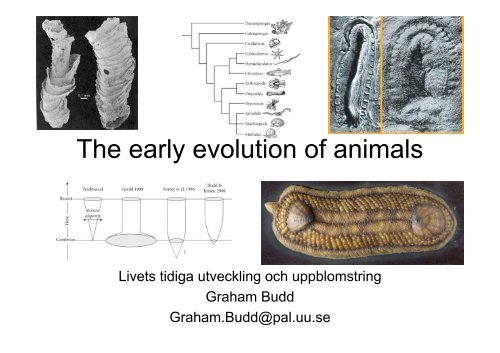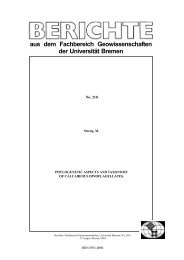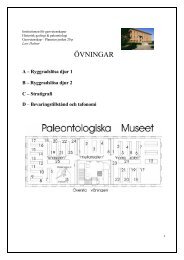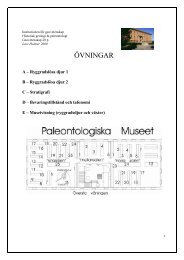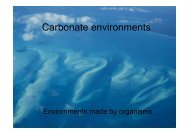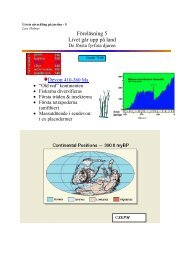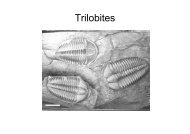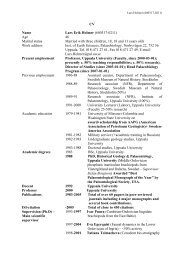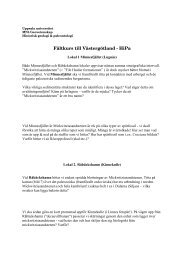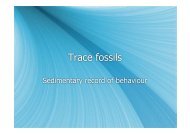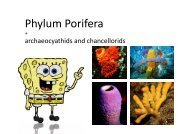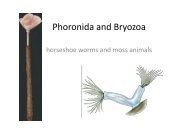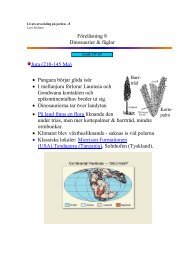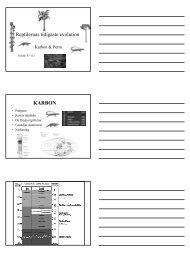The early evolution of animals
The early evolution of animals
The early evolution of animals
Create successful ePaper yourself
Turn your PDF publications into a flip-book with our unique Google optimized e-Paper software.
<strong>The</strong> <strong>early</strong> <strong>evolution</strong> <strong>of</strong> <strong>animals</strong><br />
Livets tidiga utveckling och uppblomstring<br />
Graham Budd<br />
Graham.Budd@pal.uu.se
Animal <strong>evolution</strong><br />
INTENDED LEARNING OUTCOMES:<br />
• Describe the key factors involved in causing<br />
the <strong>early</strong> <strong>evolution</strong> <strong>of</strong> animal life.<br />
• Distinguish between the various types <strong>of</strong><br />
evidence for the oldest <strong>animals</strong>.<br />
• Explain the stem and crown group concept<br />
and apply it to enigmatic fossils in the<br />
Cambrian Explosion.
<strong>The</strong> origin and <strong>evolution</strong> <strong>of</strong> <strong>animals</strong><br />
What are the <strong>animals</strong>?<br />
1. Classification and relationships between<br />
animal groups<br />
2. Invertebrate body plans<br />
What are the earliest <strong>animals</strong>?<br />
3. Evidence for the earliest metazoans<br />
What is the timing <strong>of</strong> <strong>early</strong> animal<br />
<strong>evolution</strong>?<br />
4. Precambrian-Cambrian <strong>animals</strong><br />
5. Cambrian Explosion<br />
6. Ordovician Radiation
<strong>The</strong> tree <strong>of</strong> life
Metazoa<br />
“Porifera”<br />
Cnidarians<br />
Ecydosozoa<br />
Deuterostomes<br />
Bilaterians<br />
Lophotrochozoa<br />
Protostomes
Animal classification<br />
• Animalia– all <strong>animals</strong>, with 35 separate<br />
phyla<br />
• Eumetazoa – all <strong>animals</strong> except sponges<br />
• Radiata – Ctenophores and corals<br />
• Bilateria – All <strong>animals</strong> except sponges,<br />
corals and ctenophores<br />
– Divided into Deuterostomes and<br />
Protostomes<br />
– Protostomes divided into Lophotrochozoa<br />
(or spiralia) and Ecdysozoa
Animalia<br />
• Eukaryotic and multicellular<br />
• Heterotrophic<br />
• Lack cell walls<br />
• Usually motile at some stage<br />
• Embryos pass through a blastula stage
Animal body plans<br />
• Despite a seemingly high<br />
diversity <strong>of</strong> form, there are<br />
only a few basic types <strong>of</strong><br />
animal body plans<br />
• Defined by:<br />
– number and types <strong>of</strong> enveloping<br />
tissue<br />
– Presence or absence <strong>of</strong> a<br />
celom<br />
• Evolved from a flagellated<br />
eukaryote, similar to the<br />
choan<strong>of</strong>lagellates
Sponge with choanocytes<br />
Choan<strong>of</strong>lagellates
Animal body plans<br />
• Parazoan – sponges. 2 layers <strong>of</strong> cells separated<br />
by jelly-like material, punctuated by wandering<br />
cells. No tissues or organs.<br />
• Diploblastic – cnidarians and ctenophores. Two<br />
layers = outer ectoderm and inner endoderm +<br />
epithelia. Separated by gelatinous mesogloea.<br />
• Triploblastic – bilaterians. 3 layers = outer<br />
ectoderm, mesoderm and inner endoderm. Also<br />
has bilateral symmetry and a celom (body cavity).
Animal body plans<br />
Group Grade Symmetry Key character Larvae<br />
Porifera Parazoan Bilateral<br />
and radial<br />
Choanocytes<br />
Blastual<br />
larva<br />
Cnidaria<br />
Bilateria<br />
Diploblasti<br />
c<br />
Triploblasti<br />
c<br />
Radial Cnidoblasts Planula<br />
larva<br />
Bilateral Digestive tract Various<br />
types
Metazoa<br />
“Porifera”<br />
Cnidarians<br />
Deuterostomes<br />
Ecydosozoa<br />
Bilaterians<br />
Lophotrochozoa<br />
Protostomes
Bilaterians<br />
• Divided into Protostomes and<br />
Deuterostomes<br />
• Protostomes – mouth develops directly<br />
from first opening in blastula (blastopore).<br />
Spiral cleavage.<br />
• Deuterostomes – mouth develops from<br />
second opening with blastospore giving<br />
rise to the anus. Radial cleavage.
Bilaterians<br />
• Protostomes<br />
– Mollusks<br />
– Lophophorates<br />
– Annelids<br />
– Arthropods<br />
• Deuterostomes<br />
– Echinoderms<br />
– Hemichordates<br />
– Chordates
Stem and Crown groups<br />
• crown group is the smallest monophyletic<br />
group, or “clade” to contain the last common<br />
ancester <strong>of</strong> all extant members, and all <strong>of</strong> that<br />
ancestor’s descendents<br />
• Stem groups fall close to but outside a<br />
particular crown group. E.g. Archaeopteryx
Stem and crown groups
Stems and crowns
What are the <strong>animals</strong>?<br />
SUMMARY<br />
• Animalia includes sponges plus Eumetazoa<br />
• Radiata are ctenophores and corals<br />
• Most animal phyla fall into Bilateria<br />
subdivided into Deuterostomes and<br />
Protostomes<br />
• Animal body plans vary in number <strong>of</strong> tissues<br />
layers and presence/absence <strong>of</strong> celom –<br />
Parazoan, Diploblastic, Triploblastic<br />
• Fossils should be considered using the stem<br />
and crown group concept
<strong>The</strong> origin and <strong>evolution</strong> <strong>of</strong> <strong>animals</strong><br />
What are the <strong>animals</strong>?<br />
1. Classification and relationships between<br />
animal groups<br />
2. Invertebrate body plans<br />
What are the earliest <strong>animals</strong>?<br />
3. Evidence for the earliest metazoans<br />
What is the timing <strong>of</strong> <strong>early</strong> animal<br />
<strong>evolution</strong>?<br />
4. Precambrian-Cambrian <strong>animals</strong><br />
5. Cambrian Explosion<br />
6. Ordovician Radiation
<strong>The</strong> earliest metazoans<br />
• Life began ≈ 4 billion years ago<br />
• Metazoans evolved ≈ 600 myr<br />
(molecular data)<br />
• Timing <strong>of</strong> the origin <strong>of</strong><br />
metazoans is controversial<br />
• <strong>The</strong> “Cambrian explosion”<br />
at 530 mya was a seemingly<br />
rapid appearance <strong>of</strong> <strong>animals</strong>
<strong>The</strong> old camps<br />
•Animals evolve <strong>early</strong>, were small and s<strong>of</strong>tbodied,<br />
planktonic or mei<strong>of</strong>aunal until the<br />
Cambrian explosion: the Cambrian explosion<br />
is an explosion <strong>of</strong> fossils, not <strong>animals</strong> per se.<br />
•Animals evolve late, and their <strong>early</strong> <strong>evolution</strong><br />
can be traced by studying the fossils around<br />
the Precambrian/Cambrian boundary.
<strong>The</strong> Cambrian explosion<br />
• Explosion <strong>of</strong><br />
fossils<br />
OR<br />
• An explosion <strong>of</strong><br />
<strong>animals</strong>??
<strong>The</strong> earliest metazoans<br />
• 5 lines <strong>of</strong> evidence for earliest<br />
metazoans<br />
– Body fossils<br />
– Trace fossils<br />
– Fossil embryos<br />
– Molecular clock<br />
– Biomarkers
Decline in the Stromatolites?
Metazoan evidence 1: Body Fossils<br />
Ediacaran Biota<br />
• <strong>The</strong> first assemblage <strong>of</strong> complex, multicellular<br />
organisms<br />
• Existed before the Cambrian Explosion, around 580<br />
million years ago<br />
• Affinities enigmatic and<br />
highly uncertain<br />
• Most disappeared<br />
before the Cambrian<br />
explosion<br />
• Fossils in Australia,<br />
Canada, Namibia,<br />
Russia…
Metazoan evidence 1: Body Fossils<br />
• Can be roughly divided into two groups:<br />
– Radial<br />
– Bilateral
<strong>The</strong> controversy<br />
• Older views (e.g. Glaessner, Dawn <strong>of</strong><br />
Animal Life in the <strong>early</strong> 80s) viewed the<br />
Ediacaran biota as simply old versions <strong>of</strong><br />
modern <strong>animals</strong>, and thus assigned them<br />
to sea pens, arthropods, annelids, jellyfish<br />
etc<br />
• But Seilacher and others from the mid-80s<br />
onwards questioned this view - argued<br />
lack <strong>of</strong> symmetry, preservation,<br />
construction (“Pneu” etc).<br />
• This opened a controversy still ongoing!
Ctenophores??<br />
CAMBRIAN<br />
Stromatoveris<br />
Shu et al.<br />
2006,<br />
Science 312<br />
Chen, Jun-Yuan et<br />
al. (2007) Proc.<br />
Natl. Acad. Sci.<br />
USA 104, 6289-<br />
6292<br />
Rangea<br />
Dickinsonia<br />
Zhang & Reitner 2006,<br />
Acta. Geol. Sin. 80<br />
Narbonne 2004, Science 305<br />
EDIACARAN (Dzik 2002, J. Morph. 252)
Molluscs??<br />
Conway Morris & Caron 2007, Science 315<br />
Caron et al. 2006, Nature 442<br />
Odontogriphus (Cambrian)<br />
Kimberella (Ediacaran)
Metazoan evidence 1: Body<br />
Fossils<br />
• <strong>The</strong>re are some possible metazoans in the<br />
Ediacaran, but hard to say conclusively<br />
• Taphonomy is a problem here – must treat<br />
all conclusions with caution!
Metazoan evidence 2: Trace<br />
Fossils<br />
• Trace fossils are hard to convincingly<br />
identify at metazoan<br />
• Locomotion and digestive tracts would be<br />
a good indication – burrows and trails with<br />
fecal pellets<br />
• No convincing trace fossils from older than<br />
555 Ma (White Sea area)
Oldest metazoan trace fossils?<br />
1 Ga, India 1.2 Ga, Australia<br />
Probably not!
Metazoan evidence 2: Trace Fossils<br />
Locomotory traces, 550<br />
Ma<br />
• Fecal strings, 600 Ma (Brasier<br />
and McIlroy, 1998) – first<br />
evidence <strong>of</strong> a gut? BUT fossils<br />
are questionable due to<br />
taphonomy<br />
• Trace fossils increase in<br />
complexity, 3-D exploitation, and<br />
diversity immediately before<br />
Cambrian<br />
•But – are they metazoan?<br />
Droser et al. 2002. Newfoundland<br />
Brasier and McIlroy, 1998.<br />
Scotland
Metazoan evidence 3: Fossil<br />
Embryos<br />
• Doushantou Formation in South China<br />
• 630 Ma to 580 Ma (but dates uncertain)<br />
• Marine, microscopic fossils<br />
• Sponges and corals at least, maybe<br />
bilaterians?
Yin et al. 2007 Nature 446
Doushantuo sponges?<br />
Li et al. 1998, Science 279
Metazoan evidence 3: Fossil<br />
Embryos<br />
•Taphonomy complex and not all claimed fossils<br />
are what they seem!<br />
Vernanimalcula<br />
Not a bilaterian?<br />
Chen et al.<br />
2004, Science<br />
305<br />
Bengtson &<br />
Budd 2004,<br />
Science 306
Acritarchs as animal<br />
embryos?<br />
Shuhai Xiao<br />
Yin et al. 2007 Nature 446
Metazoan evidence 3: Fossil<br />
Embryos<br />
• Doushantou embryos – cell divisions and<br />
cleavage obvious but…<br />
– Difficult to assign to distinct metazoan groups<br />
without juvenile or adult forms<br />
– Lack <strong>of</strong> clusters <strong>of</strong> 1000 cells<br />
– Could instead be stem-group metazoans<br />
– Or even fungi or rangeomorphs
Metazoan evidence 4: Molecular<br />
• Molecular clock<br />
Data<br />
– Genes accumulate changes with time<br />
– Can extrapolate back to see when lineages<br />
diverged<br />
– BUT the rates is not constant!<br />
– Bilaterians calculated to diverge anywhere<br />
between 900 and 570 Ma!<br />
– More recent values tend to value a bilaterian<br />
divergence <strong>of</strong> 570 Ma, closely matching the<br />
fossil record (sponges recently argued to be<br />
earlier - raises taphonomic “issues”)
Bilaterian origins
Time scale <strong>of</strong> animal<br />
divergences
Metazoan evidence 5:<br />
Biomarkers<br />
• Biochemical fingerprints <strong>of</strong> life<br />
• Amino acids, hopanes, hydrocarbons,<br />
isotopic fractionation <strong>of</strong> carbon, bi<strong>of</strong>ilms<br />
• Love et al. 2008 found evidence <strong>of</strong> fossil<br />
steroids from demosponges in the<br />
Cryogenian period
Love et al. 2008<br />
Sponges at 635 Ma
Metazoan evidence 5: Biomarkers<br />
• Love et al. 2008 found evidence <strong>of</strong> fossil<br />
steroids from demosponges in the<br />
Cryogenian period<br />
• But sponges are paraphyletic, which<br />
means that this type <strong>of</strong> sponge might not<br />
be a eumetazoan
What are the earliest <strong>animals</strong>?<br />
SUMMARY<br />
• <strong>The</strong> earliest records <strong>of</strong> <strong>animals</strong> are highly<br />
controversial<br />
– Bilaterian origins particularly hard to decipher<br />
• Ediacaran body fossils at best represent<br />
stem-groups<br />
• Trace fossils present but<br />
bilaterian/metazoan affinity unclear<br />
• Best evidence comes from Doushantou<br />
embryos - suggest <strong>animals</strong> (stem?)<br />
around 630 Ma<br />
• Biomarkers show at least sponges at 635<br />
Ma
<strong>The</strong> origin and <strong>evolution</strong> <strong>of</strong><br />
<strong>animals</strong><br />
What are the <strong>animals</strong>?<br />
1. Classification and relationships between<br />
animal groups<br />
2. Invertebrate body plans<br />
What are the earliest <strong>animals</strong>?<br />
3. Evidence for the earliest metazoans<br />
What is the timing <strong>of</strong> <strong>early</strong> animal<br />
<strong>evolution</strong>?<br />
4. Precambrian-Cambrian <strong>animals</strong><br />
5. Cambrian Explosion<br />
6. Ordovician Radiation
Precambrian fossils<br />
• Already discussed….<br />
– Ediacaran fossils<br />
– Doushantou embryos<br />
– Trace fossils<br />
• Small shelly fossils!<br />
Cloudina
Namacalathus
Cambrian<br />
Precambrian
Small Shelly Fossils<br />
• Precambrian-Cambrian transition<br />
• Classic in lower Cambrian <strong>of</strong> Siberia<br />
(Tommotian)<br />
• Assemblages dominated by tiny<br />
specimens<br />
• First major appearance <strong>of</strong> skeletal<br />
material, even older than trilobites<br />
• Affinities remain enigmatic in many cases<br />
• But can be more mundane – sponges,<br />
molluscs, brachiopods
Small Shelly fossils
Cloudina and Namacalathus<br />
from the youngest Ediacaran
Small shelly fossils<br />
Eccentrotheca<br />
Micrina<br />
(Skovsted et al. 2008 Geology)<br />
Williams & Holmer<br />
2002,<br />
Palaeontology<br />
Tommotiids start to find a<br />
lophotrochozoan home
Small shelly fossils<br />
Halkieria: from stemgroup<br />
brachiopod to<br />
new class <strong>of</strong> mollusc
Latouchella – First unequivocal<br />
bilaterian
<strong>The</strong> origin and <strong>evolution</strong> <strong>of</strong><br />
<strong>animals</strong><br />
What are the <strong>animals</strong>?<br />
1. Classification and relationships between<br />
animal groups<br />
2. Invertebrate body plans<br />
What are the earliest <strong>animals</strong>?<br />
3. Evidence for the earliest metazoans<br />
What is the timing <strong>of</strong> <strong>early</strong> animal<br />
<strong>evolution</strong>?<br />
4. Precambrian-Cambrian <strong>animals</strong><br />
5. Cambrian Explosion<br />
6. Ordovician Radiation
Setting the stage for the Cambrian<br />
Explosion<br />
• Environmental explanations<br />
– Glaciations<br />
– Increased oxygen<br />
• Ecological explanations<br />
– Arms race<br />
– End Ediacaran extinction<br />
– Evolution <strong>of</strong> eyes<br />
– Increased diversity/abundance <strong>of</strong> planktonics
What caused the Cambrian<br />
explosion?<br />
•Animals evolved on land, did not reach oceans until the<br />
Cambrian?<br />
•Animals adopted a “sluggish” lifestyle necessitating<br />
<strong>evolution</strong> <strong>of</strong> hard parts?<br />
•Not enough calcium in Precambrian seas?<br />
•Precambrian <strong>animals</strong> were planktonic and would be too<br />
heavy with hard parts?<br />
•Precambrian ocean too acidic?<br />
•Precambrian rocks deposited on land or destroyed by<br />
metamorphism?<br />
•Temperature drop? Or rise? Or staying the same?<br />
•Evolution <strong>of</strong> developmental genes? Or microRNAs?<br />
•Rise in oxygen levels?<br />
Etc etc
Cambrian<br />
• Break up <strong>of</strong> Pangaea I (”Rodinia”)<br />
• Most continents isolated<br />
• No continents in polar regions
Glaciations
<strong>The</strong> Oxygen Story<br />
•Commonly held that the rise <strong>of</strong><br />
the <strong>animals</strong> was impeded by<br />
low oxygen levels in the<br />
Proterozoic - indeed, this is by<br />
far the most commonly<br />
accepted explanation…only<br />
until various sinks were<br />
exhausted could the oxygen<br />
produced by photosynthesis<br />
start building up in the<br />
atmosphere.
Possible importance <strong>of</strong><br />
oxygen<br />
1. Biosynthetic - especially collagen relies on free O 2<br />
(via hydroxylation <strong>of</strong> proline and lysine)<br />
Hydroxylysine<br />
4-Hydroxyproline
Presumed prolyl 4-hydroxylases are widely<br />
(but not universally) distributed in the<br />
eukaryotes<br />
West et al. 2004, BBA 1673
Keeling et al 2005, TREE 20
Oxygen physiology<br />
•What levels <strong>of</strong> oxygen preclude <strong>animals</strong><br />
on physiological grounds?<br />
•What levels <strong>of</strong> oxygen pertained in the<br />
Proterozoic?
Oxygen physiology: aerobic vs anaerobic<br />
respiration<br />
<strong>The</strong> 3 Main Steps <strong>of</strong> Aerobic Respiration:<br />
1) Glycolysis- Makes 2 net ATP (in cytoplasm)<br />
2) Krebs Cycle- 2 ATP (in mitochondria)<br />
3) Electron Transport- 32 ATP (in mitochondria)<br />
•<strong>The</strong> last, electron transport stage is cl<strong>early</strong> an oxygen-adaptive add-on.<br />
•Krebs cycle too stops without oxygen owing to product build-up (Le Chatelier’s Principle)<br />
Anaerobic respiration thus produces much less ATP than aerobic respiration<br />
Implication is that no “free” energy is available to build complex food chains under<br />
anaerobic conditions (Catling et al. 2005, Astrobiology)
Anaerobic respiration is not all<br />
it seems…<br />
•But in fact, simple glycolysis is not the only type <strong>of</strong><br />
anaerobic respiration.
Tielens et al. 2002, Trends in Biochemical Sciences 27<br />
Anaerobic and<br />
aerobic respiration<br />
in a metazoan<br />
mitochondrion
Alternative anaerobic<br />
pathways<br />
•Fumarate replaces oxygen as final electron acceptor<br />
•Anaerobic alternatives can increase yield <strong>of</strong> ATP<br />
from 2 to between 4 and 6, and up to 8
Not all <strong>animals</strong> are aerobic<br />
sprinters!<br />
Pörtner 2002, Comp.<br />
Biochem. Phys. A 133
What were Proterozoic oxygen<br />
levels?<br />
•Very hard to tell exactly!<br />
•Most common (but not universal) to see<br />
oxygenation <strong>of</strong> the atmosphere as taking<br />
place in two steps: one about 2.4-2.2 billion<br />
years ago, the other just before the beginning<br />
<strong>of</strong> the Cambrian
What controls O2 levels?<br />
1. Oxidation <strong>of</strong> organic matter: a huge O 2 gobbler!<br />
2. Oxidation <strong>of</strong> sulphides to sulphates<br />
3. Photosynthesis<br />
<strong>The</strong>se processes can be theoretically studied by<br />
looking at isotopic levels in inorganic marine<br />
rocks (both sulphide and organic carbon<br />
production favour light isotopes); but relating the<br />
values to absolute values in the ocean is not<br />
straightforward…
Sulphur processes<br />
Reduction:<br />
SO 4 –<br />
2 => H 2 S<br />
Disproportionation:<br />
S 0 /SO 2–3 /S 2 O 3 => SO 4– 2 + H 2 S<br />
Burial rates also important (as with carbon)
Sulfur isotopes in the<br />
Proterozoic<br />
Bottrell and Newton 2006, ESR 75
Catling et al. 2005,<br />
Astrobiology 5
Bursting the oxygen bubble?<br />
•Animals are well able to<br />
generate reasonable<br />
amounts <strong>of</strong> energy<br />
under low oxygen<br />
conditions<br />
•And in any case,<br />
Proterozoic oxygen<br />
levels may well have<br />
been high enough to<br />
support complex<br />
ecologies
Setting the stage for the Cambrian<br />
Explosion<br />
• Environmental explanations<br />
– Glaciations<br />
– Increased oxygen<br />
• Ecological explanations<br />
– Arms race<br />
– End Ediacaran extinction<br />
– Evolution <strong>of</strong> eyes<br />
– Increased diversity/abundance <strong>of</strong> planktonics
• Biomineralization<br />
(crystalline or<br />
amorphous)<br />
• Total <strong>of</strong> c. 60 minerals –<br />
calcareous compounds<br />
most common (calcium<br />
carbonate) & phosphate<br />
Hard parts
Hard parts – shells and skeletons<br />
• Calcium<br />
carbonate<br />
• Calcium<br />
phosphate<br />
• Silica<br />
• Organic
Hard parts<br />
• Different types:<br />
1. Internal support<br />
2. Teeth etc<br />
3. External<br />
skeletons<br />
4. Dermal sclerites
Why Hard parts?<br />
• Arms race <strong>of</strong> predator against prey
End-Ediacaran Extinction<br />
• Mass extinctions <strong>of</strong><br />
Ediacaran fauna at<br />
end <strong>of</strong> this period<br />
• Followed by<br />
increased burrowing<br />
in <strong>early</strong> Cambrian<br />
• <strong>The</strong>re is a gap before<br />
the Cambrian<br />
explosion occurs <br />
filling the niche
Evolution <strong>of</strong> eyes<br />
• Some suggest that<br />
predator prey<br />
relationships changed<br />
dramatically with<br />
<strong>evolution</strong> <strong>of</strong> eyes
Increased planktonics<br />
• Plankton are larger in<br />
the Cambrian than in<br />
the Ediacaran, and so<br />
are their corpses and<br />
feces<br />
• <strong>The</strong>y were falling to<br />
the seafloor and<br />
accumulating<br />
• New supply <strong>of</strong><br />
energy and nutrients
<strong>The</strong> Cambrian Explosion
Cambrian fossil lagerstätten<br />
• Over 40 sites<br />
around the world<br />
• S<strong>of</strong>t part<br />
preservation<br />
• Important windows<br />
into <strong>early</strong> ecology<br />
• Closed by the<br />
Cambrian substrate<br />
r<strong>evolution</strong>
Cambrian Trilobites<br />
• Starting in the Lower<br />
Cambrian, 540 Mya<br />
• Very diverse and<br />
abundant group<br />
• Belong to Arthropoda<br />
• Exact affinities unsure
Burgess Shale<br />
• Rocky Mountains,<br />
British Columbia,<br />
Canada<br />
• Middle Cambrian<br />
• Celebrating it’s 100<br />
year anniversary <strong>of</strong><br />
discovery in 2009!
Photo courtesy <strong>of</strong> J-B. Caron<br />
Burgess Shale
Maotinashian Shale<br />
• “Chengjiang<br />
fauna”<br />
• Yunnan province,<br />
China<br />
• 10 million years<br />
older than<br />
Burgess<br />
• Almost 200<br />
species<br />
• Many arthropods
Chengjiang…
Sirus Passet<br />
• Greenland<br />
• Probably 10-15 years<br />
older than Burgess<br />
• Arthropods, sponges,<br />
other unique fossils
Orsten Fauna<br />
• Upper Cambrian<br />
fauna<br />
• Kinnekulle,<br />
Sweden<br />
• 3D preservation<br />
<strong>of</strong> outer cuticles<br />
• Only microscopic<br />
<strong>animals</strong>
<strong>The</strong> Cambrian explosion<br />
• Explosion <strong>of</strong><br />
fossils<br />
OR<br />
• An explosion <strong>of</strong><br />
<strong>animals</strong>??
Enigmatic forms<br />
Laggania<br />
• Many forms from the<br />
Cambrian Explosion<br />
have “strange”<br />
morphologies<br />
• Not immediately<br />
obvious which phylum<br />
they blong to<br />
Opabinia
Cambrian Explosion ”weird<br />
wonders”
Modes <strong>of</strong> the Cambrian<br />
Explosion
Stems and crowns
Anomalocaridids<br />
Laggania<br />
Collins, 1996<br />
Anomalocaris
Anomalocaridids<br />
• One <strong>of</strong> the largest<br />
Cambrian <strong>animals</strong><br />
• Characterized by a<br />
pair <strong>of</strong> frontal<br />
appendages, a<br />
“Peytoia”, and large<br />
eyes<br />
• Found in the<br />
Burgess Shale,<br />
Chengjiang, Sirius<br />
Passet, USA and<br />
Australia<br />
Collins, 1996
Arthropod <strong>evolution</strong> and anomalocaridids<br />
• <strong>The</strong> stem group <strong>of</strong><br />
the Euarthropoda<br />
has been highly<br />
controversial<br />
• Anomalocaridids<br />
may be stem group<br />
euarthropods,<br />
although their<br />
position is widely<br />
debated
Arthropod <strong>evolution</strong> and Hurdia
<strong>The</strong> origin and <strong>evolution</strong> <strong>of</strong><br />
<strong>animals</strong><br />
What are the <strong>animals</strong>?<br />
1. Classification and relationships between<br />
animal groups<br />
2. Invertebrate body plans<br />
What are the earliest <strong>animals</strong>?<br />
3. Evidence for the earliest metazoans<br />
What is the timing <strong>of</strong> <strong>early</strong> animal<br />
<strong>evolution</strong>?<br />
4. Precambrian-Cambrian <strong>animals</strong><br />
5. Cambrian Explosion<br />
6. Ordovician Radiation
After the Cambrian Explosion
Ordovician<br />
• New diversification after extinction in Late<br />
Cambrian: “specialists”<br />
• Diversification <strong>of</strong> vertebrates!
Ordovicium<br />
• Sea level extremely high – ”Water world”<br />
• Most continents isolated close to equator<br />
• Glaciation in Sahara<br />
• Sea level drop in Late Ordovician<br />
• Ordovician radiation <strong>of</strong> <strong>animals</strong><br />
– 3-4 x increase in number <strong>of</strong> families<br />
– Few new higher taxa (e.g. phyla) but<br />
enormous increase in families, genera and<br />
species
Cambrian<br />
Ordovician
What is the timing <strong>of</strong> <strong>early</strong> animal<br />
<strong>evolution</strong>? SUMMARY<br />
• Small shelly fossils and Cambrian<br />
Trilobites record life at Precambrian-<br />
Cambrian transition<br />
• Cambrian explosion recorded by Fossil<br />
Lagerstätten<br />
• Causes <strong>of</strong> Cambrian explosion could be<br />
ecological or environmental or combo?<br />
• Stem/crown groups let us understand<br />
enigmatic forms in Cambrian<br />
• Ordovician radiation saw huge diversity<br />
increase in species/genera level, but not<br />
many new phyla


